
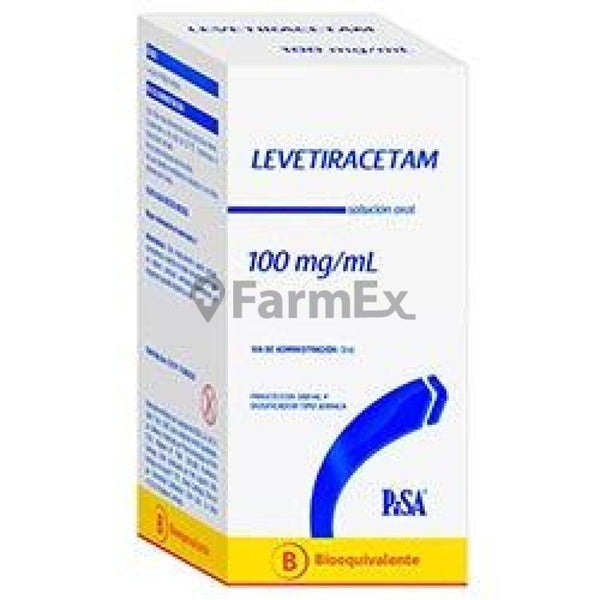
LEVETIRACETAM TARBIS 100 mg/mL ORAL SOLUTION

Ask a doctor about a prescription for LEVETIRACETAM TARBIS 100 mg/mL ORAL SOLUTION

How to use LEVETIRACETAM TARBIS 100 mg/mL ORAL SOLUTION
Introduction
Leaflet: information for the user
Levetiracetam Tarbis 100 mg/ml oral solution EFG
Levetiracetam
Read the entire leaflet carefully before starting to take this medication, as it contains important information for you.
- Keep this leaflet, as you may need to read it again.
- If you have any questions, consult your doctor or pharmacist.
- This medication has been prescribed to you only, and you should not give it to others, even if they have the same symptoms as you, as it may harm them.
- If you experience side effects, consult your doctor or pharmacist, even if they are not listed in this leaflet.
Contents of the leaflet:
- What is Levetiracetam Tarbis and what is it used for
- What you need to know before taking Levetiracetam Tarbis
- How to take Levetiracetam Tarbis
- Possible side effects
- Storage of Levetiracetam Tarbis
- Package contents and additional information
1. What is Levetiracetam Tarbis and what is it used for
Levetiracetam Tarbis 100 mg/ml oral solution is an antiepileptic medication (a medication for the treatment of seizures in epilepsy).
Levetiracetam Tarbis is used:
- alone (without the need for another antiepileptic medication) in adults and adolescents from 16 years of age or older with newly diagnosed epilepsy to treat partial onset seizures with or without secondary generalization.
- in combination with other antiepileptic medications to treat:
- partial onset seizures with or without generalization in adults, adolescents, children, and infants from 1 month of age.
- myoclonic seizures in adults and adolescents from 12 years of age with juvenile myoclonic epilepsy.
- primary generalized tonic-clonic seizures in adults and adolescents from 12 years of age with idiopathic generalized epilepsy.
2. What you need to know before taking Levetiracetam Tarbis
Do not take Levetiracetam Tarbis
- If you are allergic (hypersensitive) to levetiracetam or to any of the other components of this medication (listed in section 6).
Warnings and precautions
Consult your doctor or pharmacist before starting to take Levetiracetam Tarbis.
- If you have kidney problems, follow your doctor's instructions, who will decide if you need to adjust the dose to take.
- If you observe any decrease in your child's growth or unexpected development of puberty, contact your doctor.
- If you notice an increase in the severity of seizures (e.g., increase in number), contact your doctor.
- A small number of people taking antiepileptics such as levetiracetam have had thoughts of self-harm or suicide. If you have any symptoms of depression and/or suicidal thoughts, contact your doctor.
Taking Levetiracetam Tarbis with other medications
Tell your doctor or pharmacist if you are taking, or have recently taken, or may need to take any other medication, including those purchased without a prescription.
Taking Levetiracetam Tarbis with food, drinks, and alcohol
You can take Levetiracetam Tarbis with or without food. As a safety measure, do not take Levetiracetam Tarbis with alcohol.
Pregnancy and breastfeeding
If you are pregnant or breastfeeding, think you may be pregnant, or plan to become pregnant, consult your doctor or pharmacist before using this medication.
Levetiracetam Tarbis should not be used during pregnancy unless it is strictly necessary. The possible risk to the baby during pregnancy is unknown. In animal studies, levetiracetam has shown unwanted effects on reproduction at doses higher than those you may need to control your seizures. Breastfeeding is not recommended during treatment.
Driving and using machines
Levetiracetam Tarbis may affect your ability to drive or operate tools or machinery, as it can cause drowsiness. This is more likely at the start of treatment or when the dose is increased. Do not drive or use machinery until it is verified that your ability to perform these activities is not affected.
Levetiracetam Tarbis containsmethyl parahydroxybenzoate (E218), propyl parahydroxybenzoate, and maltitol.
It may cause allergic reactions (possibly delayed) because it contains methyl parahydroxybenzoate (E218) and propyl parahydroxybenzoate (E216).
This medication contains maltitol. If your doctor has told you that you have an intolerance to certain sugars, consult with them before taking this medication.
3. How to take Levetiracetam Tarbis
Follow your doctor's instructions for administering Levetiracetam Tarbis exactly. If in doubt, consult your doctor or pharmacist again.
The recommended dose of Levetiracetam Tarbis is twice a day, once in the morning and once in the evening, approximately at the same time each day.
Take the oral solution according to your doctor's instructions.
Monotherapy
Dose in adults and adolescents (from 16 years of age):
Measure the appropriate dose using the 10 ml syringe included in the package for patients from 4 years of age onwards.
General dose: Levetiracetam Tarbis is taken twice a day, divided into two equal doses, each between 5 ml (500 mg) and 15 ml (1,500 mg).
When starting to take Levetiracetam Tarbis, your doctor will prescribe a lower dosefor two weeks before administering the lowest general dose.
Concomitant therapy
Dose in adults and adolescents (from 12 to 17 years) with a weight of 50 kg or more:
Measure the appropriate dose using the 10 ml syringe included in the package for patients from 4 years of age onwards.
General dose: Levetiracetam Tarbis is taken twice a day, divided into two equal doses, each between 5 ml (500 mg) and 15 ml (1,500 mg).
Dose in children from 6 months of age onwards:
Your doctor will prescribe the most appropriate pharmaceutical form of Levetiracetam Tarbis according to age, weight, and dose.
For children from 6 months to 4 years, measure the appropriate dose using the 3 ml syringe included in the package.
For children over 4 years, measure the appropriate dose using the 10 ml syringe included in the package.
General dose: Levetiracetam Tarbis is taken twice a day, divided into two equal doses, each between 0.1 ml (10 mg) and 0.3 ml (30 mg) per kilogram of the child's body weight (see dose examples in the table below).
Dose in children from 6 months of age onwards:
Weight | Initial dose: 0.1 ml/kg twice a day | Maximum dose: 0.3 ml/kg twice a day |
6 kg | 0.6 ml twice a day | 1.8 ml twice a day |
8 kg | 0.8 ml twice a day | 2.4 ml twice a day |
10 kg | 1 ml twice a day | 3 ml twice a day |
15 kg | 1.5 ml twice a day | 4.5 ml twice a day |
20 kg | 2 ml twice a day | 6 ml twice a day |
25 kg | 2.5 ml twice a day | 7.5 ml twice a day |
From 50 kg | 5 ml twice a day | 15 ml twice a day |
Dosing in infants (from 1 month to less than 6 months):
For infants from 1 month to less than 6 months, measure the appropriate dose using the 1 ml syringe included in the package.
General dose: Levetiracetam Tarbis is taken twice a day, divided into two equal doses, each between 0.07 ml (7 mg) and 0.21 ml (21 mg) per kilogram of the infant's body weight (see dose examples in the table below).
Dosing in infants (from 1 month to less than 6 months):
Weight | Initial dose: 0.07 ml/kg twice a day | Maximum dose: 0.21 ml/kg twice a day |
4 kg | 0.3 ml twice a day | 0.85 ml twice a day |
5 kg | 0.35 ml twice a day | 1.05 ml twice a day |
6 kg | 0.45 ml twice a day | 1.25 ml twice a day |
7 kg | 0.5 ml twice a day | 1.5 ml twice a day |
Method of administration:
After measuring the correct dose with an appropriate syringe, Levetiracetam Tarbis can be taken by diluting the oral solution in a glass of water or in a baby bottle.
Instructions for correct administration:
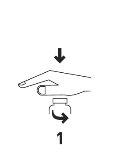
- Open the bottle: press the cap and unscrew it counterclockwise (figure 1).
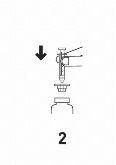 Insert the syringe adapter into the bottle neck (figure 2). Make sure it is well fixed.
Insert the syringe adapter into the bottle neck (figure 2). Make sure it is well fixed.- Take the syringe and insert it into the adapter opening (figure 2).
- Put the bottle upside down (figure 3).
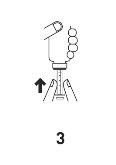
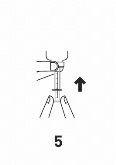

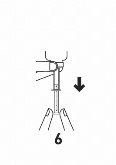 Fill the syringe with a small amount of solution, lowering the plunger (figure 4) and then raising it to eliminate any possible bubbles (figure 5), finally lowering the plunger to the graduation mark corresponding to the prescribed dose in milliliters (ml) by your doctor (figure 6).
Fill the syringe with a small amount of solution, lowering the plunger (figure 4) and then raising it to eliminate any possible bubbles (figure 5), finally lowering the plunger to the graduation mark corresponding to the prescribed dose in milliliters (ml) by your doctor (figure 6).
- Put the bottle upright.
- Remove the syringe from the adapter.
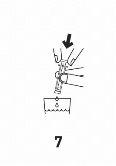 Empty the syringe contents into a glass of water or a baby bottle, lowering the plunger to the end (figure 7).
Empty the syringe contents into a glass of water or a baby bottle, lowering the plunger to the end (figure 7).
- Drink the entire contents of the glass.
- Close the bottle with the plastic screw cap.
- Wash the syringe with water (figure 8).

Duration of treatment:
- Levetiracetam Tarbis is used as chronic treatment. You should continue treatment with Levetiracetam Tarbis for the time indicated by your doctor.
- Do not stop your treatment without your doctor's recommendation, as your seizures may increase. If your doctor decides to stop your treatment with Levetiracetam Tarbis, they will give you instructions for gradual withdrawal of Levetiracetam Tarbis.
If you take more Levetiracetam Tarbis than you should
In case of overdose or accidental ingestion, consult your doctor or pharmacist immediately or call the Toxicology Information Service, phone: 91 562 04 20, indicating the medication and the amount ingested.
The possible side effects of a Levetiracetam Tarbis overdose are drowsiness, agitation, aggression, decreased alertness, respiratory inhibition, and coma.
Contact your doctor if you have taken more oral solution than you should. Your doctor will establish the best possible treatment for the overdose.
If you forget to take Levetiracetam Tarbis:
Contact your doctor if you have missed one or more doses.
Do not take a double dose to make up for missed doses.
If you interrupt treatment with Levetiracetam Tarbis:
As with other antiepileptic medications, the end of treatment with Levetiracetam Tarbis should be done gradually to avoid an increase in seizures.
If you have any other questions about the use of this medication, ask your doctor or pharmacist.
4. Possible side effects
Like all medications, Levetiracetam Tarbis can cause side effects, although not everyone will experience them.
Some of the side effects, such as drowsiness, weakness, and dizziness, may be more frequent when starting treatment or increasing the dose. However, these side effects should decrease over time.
Tell your doctor immediately, or go to the emergency department of your nearest hospital if you experience:
- weakness, dizziness, or difficulty breathing, as these may be signs of a severe allergic reaction (anaphylaxis).
- swelling of the face, lips, tongue, or throat (angioedema)
- flu-like symptoms and rash on the face followed by a prolonged rash with elevated temperature, elevated liver enzyme levels in blood tests, and an increase in a type of white blood cell (eosinophilia) and enlarged lymph nodes (Drug Reaction with Eosinophilia and Systemic Symptoms (DRESS))
- symptoms such as low urine output, fatigue, nausea, vomiting, confusion, and swelling of legs, arms, or feet, as it may be a sign of sudden decreased renal function
- a skin rash that can form blisters and may appear as small targets (dark central spots surrounded by a paler area, with a dark ring around the edge) (erythema multiforme)
- a generalized rash with blisters and skin peeling, especially around the mouth, nose, eyes, and genitals (Stevens-Johnson syndrome)
- a more severe form that causes skin peeling on more than 30% of the body surface (toxic epidermal necrolysis)
- signs of severe mental changes or if someone around you notices signs of confusion, drowsiness (drowsiness), amnesia (memory loss), memory impairment (forgetfulness), abnormal behavior, or other neurological signs, including involuntary or uncontrolled movements. These may be signs of encephalopathy.
The frequency of the possible side effects listed below is defined as follows:
Very common (may affect more than 1 in 10 patients)
Common (may affect up to 1 in 10 patients)
Uncommon (may affect up to 1 in 100 patients)
Rare (may affect up to 1 in 1,000 patients)
Very rare (may affect less than 1 in 1,000 patients)
Frequency not known (cannot be estimated from the available data)
Very common:
- nasopharyngitis;
- drowsiness (feeling of sleep), headache.
Common:
- anorexia (loss of appetite);
- depression, hostility or aggression, anxiety, insomnia, nervousness or irritability;
- seizures, balance disorder, dizziness (feeling of instability), lethargy, tremor (involuntary tremor);
- vertigo (feeling of rotation);
- cough;
- abdominal pain, diarrhea, dyspepsia (heavy digestion, heartburn, and acidity), vomiting, nausea;
- skin rash;
- asthenia/fatigue (feeling of weakness).
Uncommon:
- decreased platelet count, decreased white blood cell count;
- weight loss, weight gain;
- suicidal thoughts and attempts, mental disorders, abnormal behavior, hallucinations, anger, confusion, panic attack, emotional instability/mood changes, agitation;
- amnesia (memory loss), memory impairment (lack of memory), abnormal coordination/ataxia (altered movement coordination), paresthesia (tingling), attention disorders (loss of concentration);
- diplopia (double vision), blurred vision;
- abnormal liver function test results;
- hair loss, eczema, itching;
- muscle weakness, myalgia (muscle pain);
- injury.
Rare:
- infection;
- decrease in all types of blood cells;
- suicide, personality disorders (behavioral problems), abnormal thinking (slow thinking, difficulty concentrating);
- muscle spasms that affect the head, torso, and limbs, difficulty controlling movements, hyperkinesia (hyperactivity);
- pancreatitis (inflammation of the pancreas);
- liver failure, hepatitis (inflammation of the liver);
- skin rash that can cause blisters, which may appear as small targets (dark central spots surrounded by a paler area, with a dark ring around the edge) (erythema multiforme), a generalized rash with blisters and skin peeling, especially around the mouth, nose, eyes, and genitals (Stevens-Johnson syndrome), and a more severe form that causes skin peeling on more than 30% of the body surface (toxic epidermal necrolysis).
- decreased sodium levels in the blood.
- sudden decreased renal function
- rhabdomyolysis (muscle tissue breakdown) and increased creatine phosphokinase in the blood. The prevalence is significantly higher in Japanese patients compared to non-Japanese patients.
If you experience side effects, consult your doctor or pharmacist, even if they are not listed in this leaflet.
5. Storage of Levetiracetam Tarbis
Keep this medicine out of the sight and reach of children.
Do not use this medicine after the expiry date that appears on the carton and on the bottle after CAD. The expiry date is the last day of the month indicated.
Do not use after 7 months of opening the package.
Store in the original packaging to protect it from light. Store in a vertical position.
Medicines should not be disposed of via wastewater or household waste. Deposit the packaging and medicines you no longer need at the SIGRE point in your pharmacy. In case of doubt, ask your pharmacist how to dispose of the packaging and medicines you no longer need. This will help protect the environment.
6. Package Contents and Additional Information
Composition of Levetiracetam Tarbis
- The active ingredient is levetiracetam. Each ml contains 100 mg of levetiracetam.
- The other components are: glycerol (E422), propyl parahydroxybenzoate (E216), methyl parahydroxybenzoate (E218), ammonium glycyrrhizate, citric acid monohydrate, sodium citrate dihydrate, potassium acesulfame, maltitol (E965), grapefruit flavoring, and purified water.
Appearance of the Product and Package Contents
Levetiracetam Tarbis 100 mg/ml oral solution is a clear and colorless liquid.
Levetiracetam Tarbis is packaged in glass bottles of 300 ml or 150 ml contained in a cardboard box:
A 150 ml amber glass bottle with a child-resistant white cap, accompanied by a 1 ml graduated oral syringe and a syringe adapter. This presentationis suitable for infants from 1 month to less than 6 months of age.
A 150 ml amber glass bottle with a child-resistant white cap, accompanied by a 3 ml graduated oral syringe and a syringe adapter. This presentationis suitable for infants and young children from 6 months to less than 4 years of age.
A 300 ml amber glass bottle with a child-resistant white cap, accompanied by a 10 ml graduated oral syringe and a syringe adapter. This presentationis suitable for children from 4 years of age, adolescents, and adults.
Only some package sizes may be marketed.
Marketing Authorization Holder and Manufacturer
Marketing Authorization Holder
Tarbis Farma, S.L.
Gran Vía Carlos III, 94
08028 Barcelona
Spain
Manufacturer
Bluepharma Indústria Farmacêutica, S.A.
Cimo de Fala – S. Martinho do Bispo
3045-016 Coimbra
Portugal
Date of the Last Revision of this Leaflet: May 2017.
Detailed and updated information on this medicine is available on the website of the Spanish Agency for Medicines and Health Products (AEMPS) http://www.aemps.gob.es/

How much does LEVETIRACETAM TARBIS 100 mg/mL ORAL SOLUTION cost in Spain ( 2025)?
The average price of LEVETIRACETAM TARBIS 100 mg/mL ORAL SOLUTION in December, 2025 is around 56.64 EUR. Prices may vary depending on the region, pharmacy, and whether a prescription is required. Always check with a local pharmacy or online source for the most accurate information.
- Country of registration
- Average pharmacy price56.64 EUR
- Active substance
- Prescription requiredYes
- Manufacturer
- This information is for reference only and does not constitute medical advice. Always consult a licensed doctor before taking any medication. Oladoctor is not responsible for medical decisions based on this content.
- Alternatives to LEVETIRACETAM TARBIS 100 mg/mL ORAL SOLUTIONDosage form: INJECTABLE PERFUSION, 100 mgActive substance: levetiracetamManufacturer: Ucb PharmaPrescription requiredDosage form: INJECTABLE PERFUSION, 100 mg/mlActive substance: levetiracetamManufacturer: Ucb PharmaPrescription requiredDosage form: ORAL SOLUTION/SUSPENSION, 100 mgActive substance: levetiracetamManufacturer: Ucb PharmaPrescription required
Alternatives to LEVETIRACETAM TARBIS 100 mg/mL ORAL SOLUTION in other countries
The best alternatives with the same active ingredient and therapeutic effect.
Alternative to LEVETIRACETAM TARBIS 100 mg/mL ORAL SOLUTION in Poland
Alternative to LEVETIRACETAM TARBIS 100 mg/mL ORAL SOLUTION in Ukraine
Online doctors for LEVETIRACETAM TARBIS 100 mg/mL ORAL SOLUTION
Discuss dosage, side effects, interactions, contraindications, and prescription renewal for LEVETIRACETAM TARBIS 100 mg/mL ORAL SOLUTION – subject to medical assessment and local rules.







